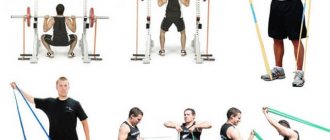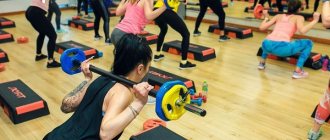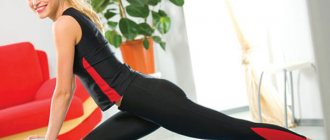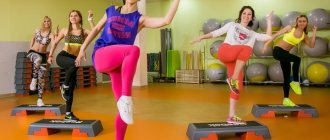Fitness as it is
Today, the word “fitness” usually refers to all types of health training, including aerobic (associated with improving oxygen metabolism in the body) exercise. In fact, the concept of “fitness” is much broader. This includes various types of physical activity (shaping, aerobics, training on simulators), and proper, rational and reasonable nutrition, and a certain daily routine, as well as various types of testing, including medical testing. In short, fitness - from English to be fit - “to be in shape” is a way of life.
When can I start?
Some modern doctors convince that healthy women who have given birth naturally and without complications can begin very light physical activity just a few days after the birth of the child. However, more conservative experts still recommend waiting a little while the body adapts to its new status and recovers from stress.
After a natural, uncomplicated birth, you can start exercising for 4-6 weeks, but these will be very gentle workouts; you can return to full exercise no earlier than 5-6 months. If there was a cesarean section or multiple ruptures, then it is best to wait until the stitches heal completely, and this may take 6-8 weeks.
To find out exactly when you can exercise, you should definitely consult your doctor before starting training.
It is important to know that during lactation, power loads can harm not only the health of the mother, but also the baby. During exercise, the level of lactic acid in the body increases, which affects the taste of milk. The baby may simply refuse the breast if you overdo it with training.
You can practice under the following conditions:
- completely healed stitches;
- woman's well-being;
- A baby’s normal reaction to breast milk after mom’s training.
Choosing a fitness club
So, you want to “get in shape”, i.e. do fitness. Where to start?
You have already done the first thing: you wanted it! If doubts still overcome you, then take a blank sheet of paper, draw a vertical line, write all the pros on the left, and all the cons of fitness on the right.
Second: just as during pregnancy, after childbirth a woman must obtain approval from her doctor for such activities.
Third: find a fitness club that’s right for you.
Making a choice is often difficult. But exciting. Especially when there is so much to choose from.
The criteria for choosing a fitness club may include the following:
- This fitness club is located near your home (work, on the way from work to home).
- Your friend goes to this fitness club.
- The price category of this club suits you.
- You are interested in the fitness program offered at this club.
- In addition to classes, you are interested in related services offered by this club. This could be a sauna, beauty salon, solarium, cafe and children's room. Agree that it is convenient, when planning training for yourself, not to wonder who will be training your child at this time, but simply take him with you.
Experts advise first of all to inquire whether the club has a license, who created it, and what qualifications the club’s fitness director has. Instructors conducting classes must have diplomas and/or certificates appropriate to their field. Do not hesitate to demand diplomas from the instructor before you have paid him the money. After all, even the most eminent champion in artistic gymnastics or bodybuilding, who does not have knowledge of how to work with ordinary people, will not be able to give high-quality and complete advice.
Club or group prices are not always an indicator of quality. In prestigious and expensive clubs there is a strict selection of personnel, so in principle illiterate instructors cannot work there. But you can be proud of the fact that you are training in the group of an ex-soloist of the Bolshoi Theater, and at the same time you will not receive full-fledged step aerobics training. Check!
So that the suit fits
Make your workout enjoyable. Totally feminine advice: buy yourself a stunning tracksuit!
The choice of clothing largely depends on the type of training. It may be easier for you to get your bearings if you visit the club for a trial lesson and see how they dress in the group where you are going to study. Be sure to talk to the instructor (coach). But there is still a certain standard set of training clothes.
First of all, it's the right shoes. Unless you decide to do yoga, where the classes are barefoot. For running, walking, cycling, regular sneakers are suitable. You may need special shoes for aerobics. Consult a salesperson at a sports store. Please note the following when purchasing:
- shoes in the sock should be about 1 cm larger (and in no case should they be too tight!);
- laces that are too long and slip are inconvenient;
- optimal breathable coating material;
- the tongue should be thick enough and not very long;
- if the heel fits tightly and comfortably, the leg will not dangle;
- The notch on the heel will provide comfort during intense ankle flexion;
- soles can be made of polyurethane (harder), but more comfortable - made of softer materials.
When buying shoes, do not forget about high-quality socks, otherwise all your efforts will be nullified.
Clothes made from 100% cotton today are no longer clearly the best, because... Cotton retains moisture for a long time, and you will sweat a lot. In stores you can choose clothes from modern materials such as coolmax, drylett, lycra, polypropylene, polyester, spandex, cotton blends, wool and wool blends.
You will also need: shorts (pants or loose-fitting breeches) and a T-shirt (top). Choosing a style and color is a pleasant procedure that will surely give you pleasure. You can even buy a short skirt or jumpsuit to hide the parts of your figure that you want. A traditional sports jacket will only be needed after classes, to move from gym to gym or from the gym to the locker room or shower (to avoid hypothermia).
Don't forget to bring your own towel. It can be useful in the gym (for wiping down seats). Also have a bag ready for your gym uniform.
"Pros" of fitness
"Minuses"
|
Workout for the soul
Next, you have to choose the type of workout that you like.
Recently, the number of fitness centers has increased significantly, and in each of them you can find a fairly wide variety of fitness programs offered.
Classical aerobics is a workout in which movements occur in the rhythm of dance, to the music.
Aerobics classes and its various subtypes usually take place in groups. You may be offered to enroll in a new group, or study in an already formed one. It is, of course, more comfortable to start with beginners. Aerobics rooms are equipped with mirrored walls so that you can see yourself and monitor the correctness of the exercises. You repeat the movements after the instructor (sometimes the lesson is duplicated on suspended TV screens).
If you don't like the music, you can talk to your coach about changing it.
The workout lasts from 30 to 60 minutes. The number of people in groups depends on the fitness club and ranges from 10 to 20. If the group is overcrowded, when doing exercises you will simply touch your neighbor, or he will touch you, or there may be a shortage of equipment (for example, mats). Therefore, clarify the question about the number of people in the group and see how comfortably they fit in the room.
Some fitness centers offer a free visit to the first training session so that you can form a final opinion on choosing a particular fitness program. If such a service is not available, ask the instructor for permission to attend his training. Most likely you will not be refused. Or agree to pay separately for the first lesson. This is a common practice.
You can pay for services monthly, quarterly, or purchase a semi-annual or annual club membership. The latter is usually cheaper.
Aerobics groups come in different levels, high and low impact. Beginners are taught basic steps and movements. At the next level of aerobics, where you will learn combinations of movements without jumping, they are of medium difficulty, moving mainly in the horizontal plane: forward and backward, from side to side. For trained clients, high-intensity lessons are offered, including difficult to coordinate combinations of movements with running and jumping.
Step (step) - aerobic training using a step platform. Due to the constant rise on the step, the load on the leg muscles increases. With the help of this seemingly ordinary step, instructors create very beautiful and interesting combinations of movements. Step aerobics can also be divided into levels of difficulty. One of the varieties of difficult-to-coordinate workouts is Double Step - a workout where each participant does not work on one platform, but uses two or even more “steps”.
Another workout using unusual equipment is fitball - a type of aerobics using a large ball. You perform exercises while sitting on or leaning on a ball.
If you love to dance, then pay attention to the training called Dance Class - classes with various elements of dance. For example, at Latino Dance (Latin dance) the basic movements in Latin rhythms are studied. There are programs in the style of Hip-Hop, Fank, Jazz, which will naturally contain elements of these dance styles. Some clubs even offer belly dancing or ballet classes.
If you don't like to dance, but want to get rid of extra calories and maintain a normal weight, go jogging, an alternative to which in bad weather can be a treadmill in a fitness club. Running strengthens the muscles of the legs, especially the thighs, and increases the body's endurance. Running also promotes the production of pleasure hormones - endorphins. A treadmill is a fairly common exercise machine, which is a moving belt, with handrails and a display panel that indicates speed, distance traveled, calorie consumption, inclination angle of the treadmill belt, and heart rate. The walkway can be equipped with holders for bottles and magazines. Before training, learn how to operate it: be sure to find out where the emergency shutdown button is!
Power training
If you decide that you need to build muscle volume and increase muscle strength, then turn your attention to a gym with weight machines and free weights. The instructor will create a training program for you, give you the necessary nutritional recommendations, teach you the technique of performing exercises, and also provide support when working with weights. Here, unlike aerobics, as a rule, classes are held individually. The instructor monitors several people at the same time, but you can always call him.
Strength classes are workouts that maintain and increase muscle strength and endurance, increase muscle mass, and also help increase bone density. Strength training reduces body fat, prevents diabetes, obesity and lower back pain. You can train with dumbbells, kettlebells, machines, resistance bands and other objects, as well as using your own body weight. Don’t be afraid, you won’t experience huge increases in muscle volume, but you will gain beautiful relief and good muscle tone. In some fitness clubs, strength training is divided into several subtypes:
Upper Body - strength class for training the muscles of the upper body (arms, chest, back, abdominals).
Body Sculpt is a strength class for training the muscles of the whole body.
ABL (abdominal, buttocks, legs) is a strength class most often chosen by ladies. These workouts specifically strengthen the muscle groups of the legs, thighs and tighten the abdomen.
Pilates is still a new modern Western trend of fitness. These compound strength exercises develop posture, flexibility and agility. Pilates is characterized by slow movements, deep conscious breathing and internal concentration.
Pay special attention to your stomach
Getting rid of the sagging belly after pregnancy as quickly as possible is the cherished dream of most new mothers. However, it is the abdominal muscles that need to be worked with extreme caution after childbirth. You need to start working closely with them no earlier than 6-8 weeks after natural birth and 2-2.5 months after cesarean section. If you rush, the sutures may, for example, come apart, intra-abdominal pressure may increase, and the vaginal walls may lower. At first, choose the most gentle type of fitness after childbirth. Again, yoga or Pilates exercises are optimal. They will also strengthen the pelvic floor muscles, which also need recovery after pregnancy.
“Be sure to complement abdominal exercises with activities to strengthen your back, because in the first years of your child’s life you will need to lift and carry him often, and for this you need a strong muscle corset,” notes Natalya Bakhireva.
If after childbirth you still have diastasis (divergence of the rectus abdominis muscles), then classic abdominal exercises with bending the torso from a lying position, with full and partial lifting of the body, and lifting the legs are contraindicated for you. In this case, breathing practices, stretching exercises and yoga are suitable.
Interval training
In addition to strength training, there are also so-called interval training - these are repeated series of intense exercises, alternating with periods of rest and recovery. They train the cardiovascular and respiratory systems, increase strength, endurance, and also strengthen and make the body more prominent. The following types of interval training are possible:
Step Interval - training with alternating aerobic work on a step platform and strength work.
TVS (Total Body Conditioning) - the use of step, slide, aerobics, various weights and rubber bands.
There is also a separate slide training . This is work using a special slippery track with limiters along the edges. Movements along it resemble the movements of a speed skater. The workout gives an excellent load on the leg muscles, the muscles of the inner thigh are especially well worked out.
CIC (cardio - intensity - conditioning) - interval training using a jump rope. The jumping part can alternate with both strength work and tai bo elements.
Tai bo (tai bo) is the name of cardio kick boxing. It involves exercises that focus on the cardiovascular system using martial arts movements, including powerful kicking and punching.
There is also eastern trend of fitness that is fashionable today. It includes various types of martial arts and yoga.
Yoga is a system of self-improvement that uses physical and breathing exercises.
This Indian practice emphasizes muscle stretching and inner peace. Each pose is held for a long time. Breathing exercises are practiced at the same time. As a result of classes, mobility, flexibility and coordination of movements develop. These exercises are especially important for strengthening the back muscles and flexibility of the spine. Yoga practiced daily helps to relax, improves blood circulation and gives energy, increases resistance to stress and the ability to concentrate.
Figure after childbirth
Many women, looking at their figure after childbirth, complain about cellulite and sagging legs and buttocks appearing after childbirth . This is also not surprising. The main reason for the formation of the notorious “orange peel” after childbirth is the action of female sex hormones estrogen , the level of which increases significantly during pregnancy. If flabby muscles of the buttocks and legs can be dealt with by increasing physical activity, then cellulite is a reason to consult a cosmetologist. To combat this scourge, many ways have been invented - from massage to the use of special creams. Cellulite is treated using herbal medicine, acupuncture, lipolysis (when electrodes are inserted under the skin into the “thickness” of cellulite, and the current destroys accumulated fat), lymphatic drainage (decomposed fat is removed with excess water), myostimulation (muscle training using electrical charges), ultrasound, mesotherapy, pressotherapy (impact on the lymphatic system with compressed air, which allows you to get rid of edema and significantly reduce body volume). However, in order to find a method that will be effective for a particular woman, you need to find out exactly the cause of cellulite, and only a specialist can do this. Another problem with your figure after childbirth, for which it is better to consult a professional cosmetologist, is the appearance of stretch marks (striae) on the skin of the abdomen, chest or thighs. A cosmetologist will help you choose the appropriate method for treating stretch marks - for some, a special cream will give optimal results, for others, more drastic measures are needed, and for others, stretch marks will go away on their own two to three months after giving birth. Finally, the already mentioned saggy belly and lack of waist cause a lot of trouble to young mothers . During pregnancy, the abdominal muscles have stretched, the abs have weakened, and besides, the fat layer from the abdomen does not want to be removed on its own. Therefore, it would be good to pay special attention to the stomach after childbirth. Exercises for the abdominal muscles should be aimed at reducing the percentage of fat, while simultaneously increasing the strength of the abdominal muscles, giving them the desired shape.











